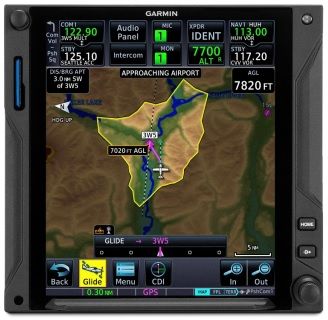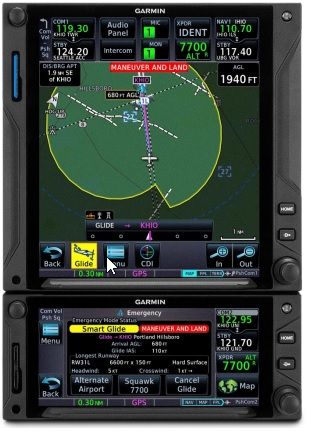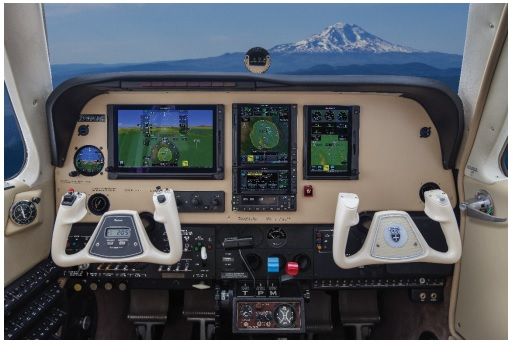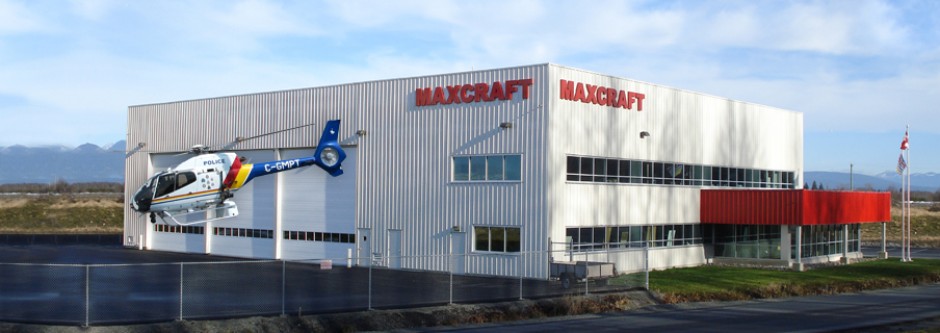Garmin is pleased to introduce Smart Glide, a revolutionary safety tool that helps the pilot in loss of engine power emergencies by automating tasks to reduce pilot workload.
the pilot in loss of engine power emergencies by automating tasks to reduce pilot workload.
Smart Glide joins the Collier Trophy winning Garmin Autoland as a part of the Autonomí™ family. In the event of the loss of engine power in a single-engine aircraft, a pilot faces the urgent, workload-intensive job of maneuvering the aircraft from its current position to a suitable airport. Through compatible avionics, such as GTN™ Xi series navigators, Smart Glide provides assistance to the pilot by recommending a suitable airport if estimated to be within glide range, as well as providing critical information to the pilot and adjusting select avionics settings. When paired with a compatible Garmin autopilot, Smart Glide can automatically engage the autopilot and pitch for the aircraft’s best glide speed while simultaneously navigating the aircraft within the vicinity of the recommended airport (if available) so the pilot can execute an approach and landing.
Smart Glide Activation and Airport Selection
In the event of engine power loss in flight, pilots can quickly activate Smart Glide using an optional dedicated Smart Glide button that can be installed via a discrete input, or by holding the Direct-to button for two seconds to initiate activation. If the discrete Smart Glide switch is installed, Smart Glide will not be able to be activated via the direct-to long press.
Once activated, Smart Glide recommends an airport estimated to be within glide range
and automatically creates a direct-to route. In the event the system estimates there is
not an airport within glide range, Smart Glide provides an aural and visual alert to the pilot, while continuing to search for an airport. Smart Glide considers several factors when choosing the recommended airport within glide range including runway length and condition; proximity; terrain; and available weather from sources such as FIS-B, Garmin Connext Weather, or SiriusXM weather, in addition to current measured winds calculated by the primary flight display (PFD). If the aircraft is equipped with a GTX 345/GTX 345R transponder or a GNX™ 375 acting as a transponder, or a GSR 56 / GDL 69/ GDL 69A with an appropriate weather subscription, Smart Glide will even consider VFR/IFR conditions when recommending the most suitable airport. Alternate airports within glide range can be selected if the pilot desires.
When Smart Glide has been activated, the system will alert the pilot with an aural message stating that Smart Glide is active, while also providing a quick reference to the selected airport within glide range in both bearing and distance to enhance situational awareness. In addition, Smart Glide provides automated adjustment of select avionics settings including changing the primary COM standby to the airport CTAF or tower and automatically switching the CDI to GPS mode. If the aircraft is appropriately equipped and configured with a compatible Garmin transponder, Smart Glide also provides pilots with a
stating that Smart Glide is active, while also providing a quick reference to the selected airport within glide range in both bearing and distance to enhance situational awareness. In addition, Smart Glide provides automated adjustment of select avionics settings including changing the primary COM standby to the airport CTAF or tower and automatically switching the CDI to GPS mode. If the aircraft is appropriately equipped and configured with a compatible Garmin transponder, Smart Glide also provides pilots with a
shortcut to tune the transponder to squawk the 7700 emergency code. If the aircraft is equipped with a compatible Garmin autopilot, Smart Glide activation will also automatically engage the autopilot to pitch for the best glide airspeed and activate GPS
mode to enable navigation to the recommended airport. When equipped with a compatible Garmin autopilot, in the event the system estimates there is not an airport within glide range, the aircraft will automatically pitch for configured best glide speed.
Access Critical Information
Using the Smart Glide Page and the Map Page of the GTN Xi,pilots can easily access critical Smart Glide information when they need it most and better prepare for a landing at a potentially unfamiliar airport. The Smart Glide Page displays estimated glide speed based on the specific aircraft, airport name, an alternate airport list, arrival above ground level (AGL) altitude, longest runway information including wind components if available, as well as a Smart Glide alert banner to keep the pilot notified of glide status and any pertinent instructions. The Map Page is another useful resource for pilots during a Smart Glide activation. The Glide Range Ring depicted on the Map Page shows available airports within glide range and dynamically adjusts based on winds and terrain. The Map Page displays current aircraft AGL altitude, as well as estimated AGL altitude upon arrival, bearing, and distance to the airport, while decluttering the map.
Approach and Landing
When the aircraft is within four nautical miles from the recommended airport, Smart Glide will alert the pilot that they are approaching the airport environment with both an aural alert and visual banner. Within two miles of the airport, audible airport position alerts and a flashing red alert displayed on the GTN Xi will advise the pilot to resume control and begin maneuvering for a safe landing. In the event of an off-airport landing, Smart Glide provides audible AGL altitude alerts to help ensure the pilot is aware of the altitude while maintaining their focus on landing locations.
Smart Glide Support with a Variety of Garmin Systems
In certified aircraft, Smart Glide will become available with a GTN Xi series navigator paired with a compatible Garmin flight display including the G500 TXi™/G600 TXi, GI 275 electronic flight instrument, the G3X Touch™, or G5 electronic flight instrument, with others to be added later. Compatible Garmin autopilots such as GFC 500 or GFC 600 can be automatically engaged when Smart Glide is activated. Please note that initial Smart Glide software interface with a GFC 500 or GFC 600 works with GI 275 and TXi installations only. G5 configuration compatibility is expected in Q4 of 2021. For aircraft without a compatible Garmin autopilot, Smart Glide will still provide critical information and features to help manage engine emergencies and help to reduce pilot workload. Further, experimental aircraft with G3X Touch and a G3X autopilot can also enable Smart Glide technology when appropriately equipped.
Smart Glide is expected to be available as a software upgrade through Maxcraft Avionics starting in August 2021.
Need to know more about this amazing product? Call us or visit our team at Maxcraft Avionics!
Maxcraft Avionics is a leader in airplane and helicopter avionic system upgrades, including installation of everything from basic VHF Radios and flight instruments, all the way to sophisticated GPS, TCAS, EFIS, and glass cockpit systems. We have the largest avionics facility in Canada and over 20,000 unique part numbers in our inventory to repair your aircraft or upgrade your cockpit.



